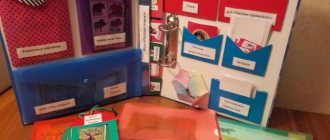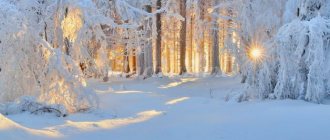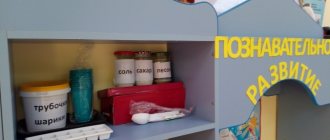From the pages of a textbook
This project work completes a large section of the textbook called “Nature”. And the “red book” is the name of one of the paragraphs of this section.
Let's see what is required of us?
ABOUT! Our good friends are Seryozha and Nadya, inquisitive inhabitants of the textbook. They did something again. Or rather, they did. This time the guys came up with their own Red Book. They placed insects, plants, and animals on her pages. And our children are encouraged to do the same.
That is, you need not to repeat the real, really existing Red Book, but to make your own. It turns out that you can add into it not only those animals and plants that are already under protection, but also any others you want. Well, this expands our capabilities.
In what form should the project be presented? It seems like they are asking to make a Red Book. And the Red Book is, strictly speaking, a book.
But! In the workbook, space is also reserved for this project. This means that it can be done in a notebook.
Let's start with it.
Report-message “Red Book”
The Red Book is a special list that contains all species of animals, plants or fungi that are extinct or on the verge of extinction at the moment.
History of the Red Book
The idea of creating such a document first appeared in 1902, when the International Convention for the Protection of Birds Useful in Agriculture was signed in the capital of France, Paris. After more than 40 years, in 1948, the IUCN (International Union for Conservation of Nature and Natural Resources) was born, which was supposed to create a list of endangered animals and birds and provide them with protection. Over time, the organization was renamed the World Conservation Union, but the abbreviation remained. Since the 1960s, Red Books began to be published en masse in many countries around the world. The document in question contains generalized information about rare species, their numbers and characteristics. Based on the materials obtained, various measures are being developed to protect and restore endangered species. The color red symbolizes the danger that threatens our Earth. In this way, scientists are trying to show people how important it is to take care of endangered species of animals, and to attract their attention to this problem. The pages of the very first book were indeed painted red.
Red books vary in levels. They are regional, national and international.
Red Data Book of the Russian Federation
Russia, like many other countries, has its own Red Book. She appeared in 2001. At that time, it included more than 850 pages containing information about rare animals and pictures depicting them. Information is constantly updated. Sometimes new species are added to the book. Others, thanks to measures taken to protect them, which are no longer considered rare, are removed from the Red Book. All types of flora and fauna listed in the Red Book are divided into 5 categories and are located on pages of different colors: 1) endangered species - special measures are required to protect and preserve them, because their existence is in real danger (red pages) 2) rare species - there are quite a few representatives of these species left, they live in a limited area, and there is a possibility of their extinction. Although they are not directly threatened (white pages) 3) endangered species - the number of individuals is rapidly declining (yellow pages) 4) uncertain species - there are no exact facts about the number of individuals, but they are likely to be in danger (gray pages ) 5) recovering species - those that are no longer on the verge of extinction due to protection measures (green pages). The Red Book of Russia is a special document, the compilation of which is under the control of the government of the Russian Federation. Every ten years, the Red Book should be republished, introducing the necessary changes to the list. This is done by the Federal Service for Supervision of Natural Resources. Since the 1980s, many republics of the USSR began to publish local regional Red Books. At the moment they exist in most regions, territories and republics of the Russian Federation.
Environmental protection is becoming more and more important every day because many species of animals and plants are facing the threat of extinction due to various reasons. This is why the Red Book plays such a significant role in the modern world. It contains recommendations for protective measures that, if followed, can preserve and restore endangered species.
Project protection
What does it mean to protect a project? This means giving a short presentation of your work in front of the class. Pick up (in this case) a notebook, go to the board, speak briefly on the topic of work, adhering to a pre-planned plan.
The main thing is not to go too deep. 5 minutes is the maximum maximum! There are many people who are passionate about, as well as those who are forced to))) defend their work in the classroom. So save your time. The lesson, as they say, is not rubber-stamp.
The hardest thing is to start. Why? And from the definition of the Red Book, which is already written in the workbook. This will be a great short introduction that will easily flow into the first point of our plan.
In practice it might look like this:
Great! A start! The first point of the plan has been completed. Let's try to move on to the second, which involves telling a story about the benefits that the “residents” of the project bring.
There are 12 “inhabitants” in our book. There is no need to talk about everything during the presentation. Four will be enough.
But! It is necessary to know about the benefits of the remaining eight. Don’t forget that defending a project involves answering questions from listeners. One of your classmates may ask about the benefits of a specimen not mentioned in the presentation. So, be prepared for this.
Well, we still have the final point of the plan about ways to protect animals and plants.
If you think about it, it turns out that the methods of protection are universal for all representatives of ours, and any other Red Book.
- Do not kill (do not pull out, do not trample, do not chop if we are talking about plants).
- Help in difficult times (for example, feed or treat).
- Do not pollute, take care of nature (do not litter, do not burn fires in forests, do not dump waste into rivers and lakes, install treatment facilities on factory pipes, etc.)
- Restore (plant trees, go to cleanup days, etc.)
It is clear that a child will not go to a factory and install a modern filter on a pipe. But he is quite capable of not picking a flower, not breaking a tree, not killing a beetle, not throwing a candy wrapper past the trash can.
Well, we figured out how to make a project in a workbook and how it can be presented.
Let's move on to the next, more creative way of designing this work. We will make a real Red Book. Although, rather not a book, but a book that you can bring to school in your pocket.
Mammals
The list of mammals in Russia includes about 300 species. Of these, several dozen representatives of the animal world are included in the KKRF. They belong to the following groups:
- Predatory;
- Insectivores;
- Chiroptera;
- Rodents;
- Cetaceans;
- Pinnipeds;
- Artiodactyls;
- Odd-toed ungulates.
Amur tiger
The Amur or Far Eastern tiger lives in the southeastern part of Russia. This is a protected area spreading along the banks of the Ussuri and Amur rivers. According to the 2015 census, the number of these animals was 523-540 individuals.
Amur tiger
For example, in 2013 there were fewer tigers - 450. The main reason for the extinction in the 19th century was human activity - every year the number of tigers decreased by an average of 100 individuals.
Experts plan to resettle Amur tigers in the area of the Pleistocene Park (Yakutia).
Then it will be possible to increase their population to 75 individuals. But for this it is necessary to increase the population of artiodactyl animals, which form the basis of the tiger’s diet. In addition to deer, roe deer, and moose, they feed on small animals, birds, and fish. Tigers need about 10 kg of meat per day. Interesting fact : the Amur tiger is the only subspecies that has a 5 cm thick layer of fat on its belly. It helps animals survive even at very low temperatures.
Far Eastern leopard
Amur leopard, East Siberian leopard - this predator has up to 5 names. It is considered the rarest subspecies. According to 2022 data, 87 individuals live in Russia. Their habitat is the Land of the Leopard National Park.
Far Eastern leopard
The decline in the number of Far Eastern leopards is associated with poaching. This includes the animals that these predators feed on. People are also destroying forests, a natural habitat. Due to the small number of the species, leopards reproduce within the same population, which has a bad effect on genetics.
The predator is nocturnal and hunts alone. The diet consists of other animals of any size, mainly ungulates. Large prey lasts a leopard about a week.
Snow leopard (irbis, snow leopard)
A large predator from the cat family, it is common in the mountains of Central Asia. In Russia these are Altai, Tuva, Krasnoyarsk Territory, Khakassia, Buryatia, and the Eastern Sayan mountain system. Due to the difficult conditions in which the snow leopard lives, it is one of the least studied species of its family. Perhaps the snow leopard population has not completely disappeared precisely because of its habitat.
Snow Leopard
According to estimates in 2022, the number of snow leopards in Russia is 63-64 individuals, of which there were more than 10 kittens. Evidence suggests that the population remains relatively stable. 2-3% of the total number of snow leopards live on the territory of the Russian Federation.
Officially, hunting snow leopards is prohibited. However, poaching continues to harm their population. Predators also suffered as a result of mass poisoning of rodents, which are part of their diet, with pesticides. Snow leopards lead a predominantly solitary lifestyle, but family groups are sometimes found. They feed on ungulates and small animals.
Central Asian leopard or Caucasian leopard
In Russia it is found in the North Caucasus. The Central Asian leopard lives in forests and dense bushes, preferring to stay close to rocks and stones. Predators feed on medium-sized ungulates (deer, mouflon, wild boar, etc.), and sometimes on small animals.
Central Asian leopard
The problem of the population of Caucasian leopards is more than relevant. There are about 1000 of them preserved in the world. The main cause of extinction is human activity. The exact number of animals within the Russian Federation has not been established. However, in 2007, a special program was approved to restore the leopard population in the Caucasus.
Sea lion
The sea lion or northern sea lion is the largest species in the eared seal family. Belongs to the second category of animals, that is, those whose numbers are declining. In Russia, sea lions began to noticeably disappear in 1890-1990 - from 115,000 to 15,000 individuals. According to the latest data, their population in Russian waters is about 20,000.
Interesting: What are clouds? How clouds form, main types, characteristics, photos and videos
Sea lions
Animals are found in the waters of the Sea of Okhotsk, Bering, and Japan, as well as along the Kuril Islands and Eastern Kamchatka. Sea lions prefer coastal areas and islands. Their life cycle consists of migrations and rookery periods.
The exact reason for the decline in the number of northern sea lions has not been established. Main factors: fishing, water pollution, warming, catching fish, which forms the basis of the diet of sea lions. Steller sea lions also have natural enemies - killer whales and brown bears.
Walrus
Walruses are the only representatives of their family. Juveniles are easy to distinguish from adults: the latter have huge tusks. According to the main classification, these pinnipeds are divided into Pacific and Atlantic. Another subspecies is the Pacific Laptev walrus.
Walrus
Interesting fact : the walrus is the largest species in the group of pinnipeds after the elephant seal. However, walruses and elephant seals are not found in the same areas, so the walrus family can be called the largest in its range.
The Atlantic and Laptev walruses are listed in the KKRF. The population of the first species in Russia is about 20 thousand, the second – up to 10 thousand individuals. In the case of the Atlantic walrus, the number of individuals was significantly reduced due to uncontrolled fishing. The population is also affected by climate change, natural enemies, and parasites.
Walruses live in the waters of the Chukchi, Bering, Kara, East Siberian, and Laptev Seas. They prefer coasts and do not move long distances.
harbor seal
The common seal is a predatory mammal, two subspecies of which (European and Kuril) are listed in the Red Book of Russia. Seals are common in the seas belonging to the Arctic Ocean. They live in the coastal zone, bays where strong winds do not blow. There is also a population of seals on the Commander Islands.
harbor seal
The number is declining for several reasons: poaching, global warming, human activity in the coastal zone, attacks by natural enemies (polar bears, killer whales). The number of individuals has recently been 4-6 thousand.
Narwhal
The narwhal is the only representative of its genus. It is included in the 3rd category of animals, as a rare species with a small number of individuals. The exact number of narwhals is unknown, but in 2022 scientists discovered about 30 individuals, including calves.
Narwhal
The usual habitat is the waters of the Arctic Ocean and the northern part of the Atlantic. Narwhals suffer most from poaching, as well as from natural predators - killer whales, polar bears, polar sharks.
bottlenose dolphin
The bottlenose dolphin (large dolphin) is a species of dolphin. There are several of its subspecies. In particular, the Black Sea bottlenose dolphin, which lives in the waters of the Black Sea (about 7 thousand individuals), is listed in the Red Book of Russia.
bottlenose dolphin
Since 1996, fishing for these dolphins has been prohibited. Bottlenose dolphins are disappearing for many reasons: fishing, netting, poaching, pollution of ocean waters with household waste, noise pollution.
Bottlenose dolphins prefer a sedentary lifestyle or move in small groups. As a rule, they live near the coast, which is explained by the nature of their diet. The diet of dolphins includes a variety of fish.
Interesting fact : a characteristic feature of bottlenose dolphins is their well-developed cognitive abilities. For example, they understand gestures, monitor their behavior, imitate people, etc.
Blue whale
The blue or blue whale belongs to the category of baleen whales. It is both the largest representative of cetaceans, and also, apparently, the largest animal that has ever lived on the planet (up to 33 m in length and weighing more than 150 tons).
Blue whale
Among the three subspecies, the northern blue whale is listed in the CCRF. It is considered typical because it was the first discovered and described. In general, blue whales are considered cosmopolitan - that is, widespread. However, they are rare in Russian waters. For example, near Cape Lopatka (Kamchatka).
The greatest threat to whales has become active fishing, which has been officially prohibited since 1966. The exact number of individuals is difficult to establish - different sources provide conflicting data. If in the 19th century the number was several hundred thousand, now it is up to 5000.
Currently, blue whales are suffering due to collisions with ships, water pollution, and increased noise levels. They also get entangled in nets.
Polar bear
The polar bear ranks second among the largest land predators (after the saltwater crocodile). Within the Russian Federation, the species is distributed in the waters of the Bering and Chukchi Seas, as well as on the Arctic coast of the Chukotka Autonomous Okrug. This is where the largest population in the world is concentrated.
Polar bear
Polar bears feed on marine mammals. They lead a solitary lifestyle. The animals are threatened by poaching, since hunting them has been prohibited in the Russian Federation since 1956. At the same time, polar bears have low reproductive potential. The number of species in our country is up to 7000.
Interesting: The largest predators in Russia - list, description, size, photo and video
Altai mountain sheep (argali)
The Altai mountain sheep is a subspecies of argali (or argali) and lives in the South-Eastern Altai, in the south-western part of Tyva. These artiodactyls prefer mountainous areas, where they periodically migrate in a vertical direction (in search of plant food).
Altai mountain sheep
It is difficult to control the number of Altai sheep due to their natural habitat. Officially, the subspecies is endangered. The reasons are uncontrolled hunting, the need to leave the habitat (due to grazing of livestock and a decrease in the amount of food), natural enemies.
Reptiles
Approximately 70 species of animals represent the class of reptiles in the country. About 20 species are listed in the KKRF. They are common on the coast of water bodies and in forest areas.
Far Eastern skink
Far Eastern skink
The Far Eastern skink is a genus of lizards. Lizards live on Kunashir Island - near forests and on the river coast. The number is several thousand individuals. Predators such as minks and economic activities pose a danger to lizards.
Common copperhead
A representative of the colubrid family in Russia, it is distributed in the southern part of European territory. Copperheads swim well, but they try to avoid dampness, preferring dry meadows and clearings. The main diet consists of lizards.
Common copperhead
The danger for them comes from birds of prey, hedgehogs, rats, etc. Copperheads are also often mistaken for poisonous snakes. The main reason for the population decline is the use of pesticides in agriculture.
Gyurza
The viper is the largest representative of the genus of poisonous vipers. The most common in the South Caucasus (Transcaucasian viper). The main diet consists of rodents. It is considered a species whose numbers are declining. Currently there are about 1000 individuals. This happens mainly due to human activity.
Interesting: Why don’t polar animals freeze their paws on the ice?
Gyurza
Interesting fact : the venom of the viper is unique and very dangerous. In toxicity it is second only to cobra venom. Widely used in medicine and pharmacology.








